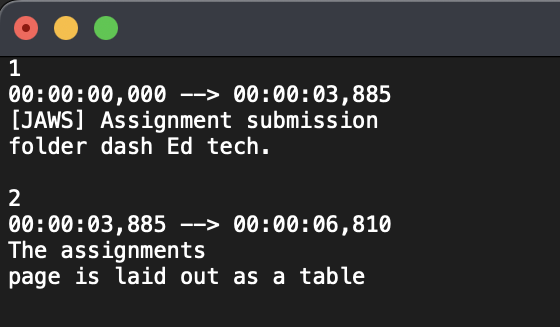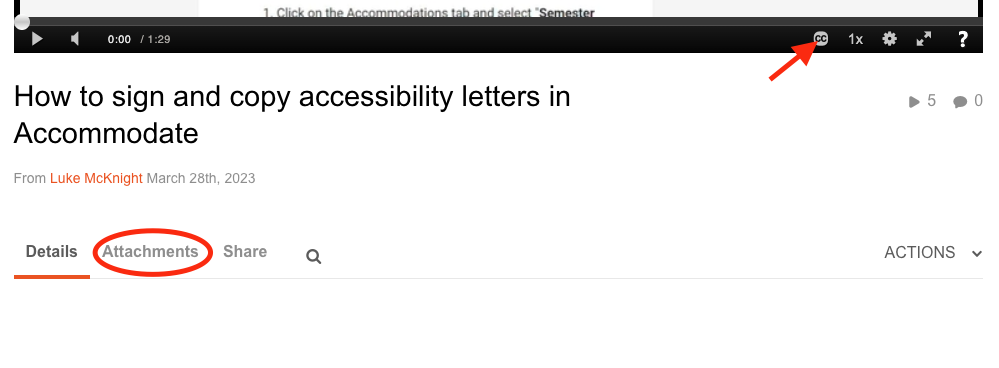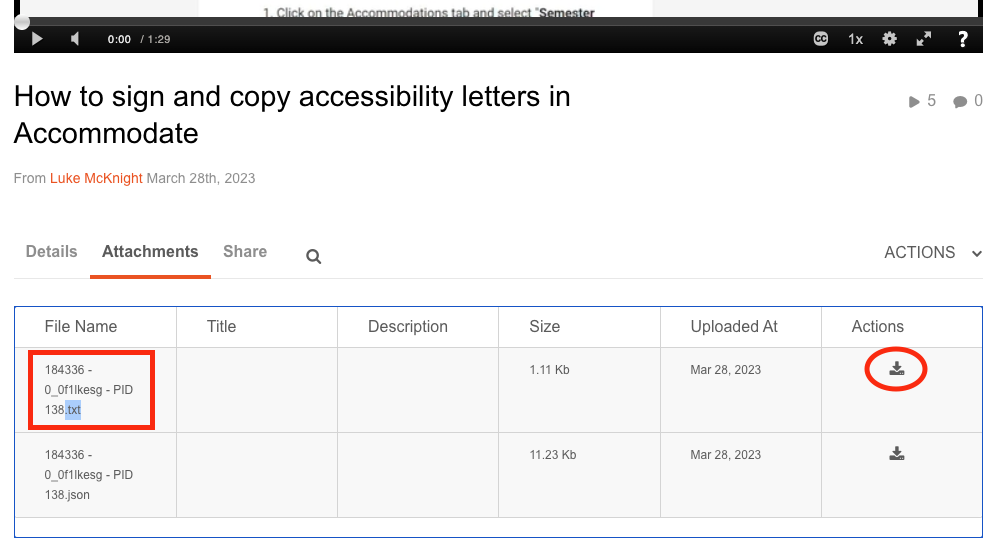Accessibility FAST
Captioning and Transcription Tools
On this page:
Captioning on Common Video Platforms
OneDrive and SharePoint
- Open a video file in OneDrive/SharePoint
- Select Video settings in right hand toolbar
- Select Transcript and captions
- Click Generate
- Select Spoken language
- Click Generate
- Once captions have been generated, select Transcript in right hand toolbar
- Click Edit beside any caption that requires changes
To download subtitles:
- Click Download in the Transcript panel
- Select Download as .VTT
Zoom
Zoom supports live captioning and automatic transcription.
Transcription can be provided by a live transcriber in the meeting, a third-party service, or Zoom’s automatic live transcription. If your Zoom meeting is recorded, you can upload the video file and add captioning just like you would to any other video.
Teams
Microsoft Teams meetings support automatic transcription with speaker attribution.
- Select the … More actions button
- Choose Start Transcription
Consider this guide for information on live transcription in Teams.
YouTube
YouTube supports manual captioning, automatic captioning, and uploading a transcript or caption file.
Add subtitles and captions to YouTube content.
Manually add captions to YouTube content.
Edit or remove captions from YouTube content.
YouTube guide to automatic captioning. Note: YouTube auto captions are particularly inaccurate.
Screenpal/Screencast-o-matic
Deluxe/Premier accounts can automatically generate captions and all accounts can manually add captions. Read Screencast-o-matic’s guide to accessible video.
Camtasia
Camtasia offers automatic captioning. Read this guide from Camtasia on the available captioning methods.
Vimeo
Vimeo has support for uploading caption and subtitle files. Enterprise members have access to automatic captioning.
Dailymotion
Dailymotion offers support for adding .SRT subtitle files to videos.
HTML 5
To add closed captioning to an HTML5 video player <video>:
- Acquire or make a WebVTT caption file (.VTT).
- Use the auto captioning services available and edit to approach 99% accuracy.
- You can often download .VTT files from some media hosts.
- If not, use 3playmedia or happyscribe to convert the more common .SRT caption type to .VTT file.
- Upload .VTT file to same folder as video.
- Add a <track> element within your <video> tag.
- src – URL location of the .VTT file on server.
- label – title of the track as it displays in player (i.e. English).
- kind – captions, subtitles, descriptions are possible options.
- srclang – language of file.
- default – indicates which file is to be the default.
Mozilla’s in-depth article on WebVTT is an excellent resource.
3playmedia code examples on HTML5 video captions is a good starting point.
Find Captioned Videos on YouTube
An excellent way to ensure you are providing accessible videos to learners is to choose sources that already have captions. On YouTube, you can filter search results to only display videos with captions. To do so:
- After entering your search term, select the Filters button.
- Select Subtitles/CC.
- Double check that results display Subtitles.
- Beware of videos with “English (auto-generated)” captions as auto-generated captions are less accurate with human-edited captions.
Social Media
Instagram supports captions on Stories and IGTV.
Captions can be added to stories using a sticker.
IGTV captions must be turned on in settings.
TikTok offers support for automatic captioning.
Twitter offers support for adding .SRT files to videos.
Facebook supports adding captions to Facebook video.
Creating Caption Files
Caption files can be created using a text editor (like Notepad for Windows or TextEdit on MacOS) to create or edit .SRT files (.SRT and .VTT are the most common file formats for subtitles).
How to:
Create .SRT File
- Open Notepad or TextEdit (macOS)
- Type “1”
- Press Enter to a new line
- Enter beginning and end timecode, using this format
- hours:minutes:second,milliseconds –> hours:minutes:second,milliseconds
- Example: 00:00:00,00 –> 00:00:05,443
- Press Enter
- Type your captions
- Limit to 2 lines of text per caption sequence
- Press Enter twice to leave a blank line, indicating a new caption sequence
- Type “2”
- Press Enter
- Entering beginning and end timecode
- Press Enter
- Type captions
- Repeat
- When complete, save your file using .SRT as the file extension.
Create .VTT File
- Open Notepad or TextEdit (macOS)
- Type “WEBVTT”
- Press Enter twice
- Enter beginning and end timecode, using this format
- hours:minutes:second.milliseconds –> hours:minutes:second.milliseconds
- Example: 00:00:00.000 –> 00:00:05.443
- Press Enter
- Type captions
- Limit to 2 lines of text per caption sequence
- Press Enter twice to leave a blank line, indicating a new caption sequence
- Repeat above
- You can number your caption sequences (by adding a number on the line above the timecode), but it is not required.
- When complete, save file with .VTT file extension
Here is an example of the proper formatting of an .SRT file in TextEdit:

Consider this guide for manually creating and editing .SRT files.
Use HappyScribe’s convert SRT to VTT tool or 3Play Media’s caption converter tool if you need a different file format.
For instructions to upload caption files, consult the platform guides earlier in this chapter.
Transcripts
Transcripts are a text document containing all the audio content in media, including videos, podcasts, and audio recordings. Transcripts may also include additional information regarding visual elements and actions such as descriptions of what is on screen. Unlike captions, transcripts are not timestamped or synced with the media. A transcript is particularly useful to text to speech and screen reader users because many users set their software to read at a rate much faster than natural human speech. Transcripts can also be searched for words, names, and terminology.
Use Kaltura to generate a transcript of audio or video:
- Upload media to Kaltura
- Edit machine-generated captions
- Navigate to media
- Select Attachments

- Choose the Download icon for the .txt file attached to the video

- The .txt file downloaded will be a text equivalent of the closed captions but without timestamps.
OneDrive
If you generate transcripts using OneDrive, follow the instructions earlier in this chapter to create captions. Then, download the generated .VTT and use Microsoft VTT Cleaner to remove timestamps and other code.
Other Captioning and Transcription Tools
Use Word to transcribe either by recording directly in Word or uploading an audio file.
Transcribe audio to text using Dragon Naturally Speaking.
Audapolis is an open source transcript editor that automatically transcribes audio to text.
Mac OS supports dictation that could be used to develop a transcript.
Google Docs allows dictation that could be used to write a transcript.
Google Chrome now offers live captioning on any video. This feature does not absolve content creators/providers from adding captions to video content, however, if encountering a video without captions on the wild web, this feature can be invaluable. This tool relies on the built-in captioning settings on your computer. To view or change these settings:
Transcription is the process of converting audio into written text. A transcript is a written record of all audio in media. Captions are synced to the content.

